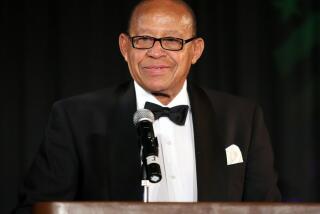Keith Fuller, 79; Led AP Into High-Tech Era
Keith Fuller, who as president of Associated Press for nearly a decade guided the world’s largest news-gathering organization into an age of stories and pictures transmitted by satellite instead of telephone and teletype, died Friday. He was 79.
Fuller, who had suffered from Alzheimer’s disease, died at his home in Chevy Chase, Md.
His four decades with AP included a stint as bureau chief in Little Rock, Ark., in the 1950s. He directed coverage of the 1957 school desegregation crisis at Central High School, for which AP Special Correspondent Relman Morin won a Pulitzer Prize.
Fuller also was supervising editor for “The Torch Is Passed,” AP’s account of President Kennedy’s assassination, which sold 5 million copies in hardcover and was translated into eight languages.
When Fuller retired as AP’s president and chief executive in 1985, the news cooperative had 1,800 reporters, editors and photographers in 219 bureaus worldwide, and was serving newspapers with 90% of the country’s daily circulation.
He increased the number of AP’s overseas bureaus, expanded the range of live broadcast news and took the first steps toward diversifying its sources of income.
Edwin Keith Fuller was born in 1923 on his family’s 320-acre wheat farm near Arlington, Kan. He was 15 when his father died and he was sent to live with his older married brother in Beaumont, Texas.
There he edited the high school newspaper, discarded his first name as “unfit for a cowboy” and acquired a baritone drawl.
A freshman at Lamar College, he was also working full time as a $13.50-a-week cub reporter on the Beaumont Enterprise when World War II broke out.
Enlisting in the Air Corps cadet program, he went overseas with the 8th Air Force as a navigator-bombardier on a B-17.
On his 10th mission with the 457th Bomb Group, his plane caught fire from flak, and he bailed out at 21,000 feet over Nazi-occupied Nancy, France.
Fuller spent the next 14 months in a series of Stalag-lufts, POW camps for airmen, until U.S. 3rd Army tanks battered down the gates of Stalag VIII-A, outside Munich.
Certain that he would not survive the camp’s liberation, Fuller ventured out from beneath his bunk only when he saw Gen. George S. Patton himself, in full military regalia with ivory-handled pistols, handing out C-rations to the jubilant inmates.
After the war, Fuller entered Southern Methodist University with the idea of becoming a lawyer, but dropped out to return to journalism.
In 1949, he received an offer from United Press, but instead joined AP in New Orleans. He worked for AP in Mississippi, Texas, Arkansas and Denver before moving to AP headquarters in New York as a general executive in 1960.
He took the post as AP’s chief executive, succeeding his friend and mentor Wes Gallagher, just as the media’s technological age was dawning.
“My first capital budget was something like $800,000,” he would say. “Within a few years, I was scrounging for $16 million or $17 million, just to buy equipment. And laptops for every reporter had not yet landed in my lap.”
To emphasize AP’s place in international journalism, Fuller led visits by the cooperative’s board of directors to various news spots around the world, notably to China in 1977, when they were received by Premier Deng Xiaoping, and later to Tibet.
In 1981, he was given the William Allen White Award by the University of Kansas and a year later received an honorary doctorate of letters from Ithaca College in New York.
After his retirement, Fuller served for 10 years on the board of directors of Gannett.
He was succeeded at AP by Louis D. Boccardi, who remains president and chief executive.
Fuller is survived by his wife, Mattisue Scott; a daughter; and two sons.
More to Read
Sign up for Essential California
The most important California stories and recommendations in your inbox every morning.
You may occasionally receive promotional content from the Los Angeles Times.










